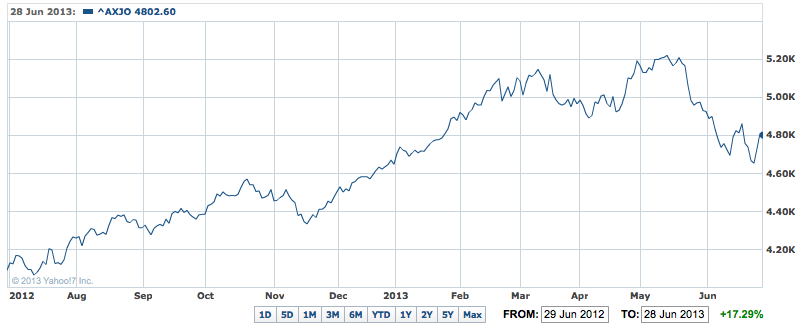Lot’s of statistics over the weekend from home and offshore about the way markets went for the financial year as well as the June quarter, the month of June and the last week of the month.
But one figure stood out for what it did to markets and meant for investors large and small here and offshore.
That was the surge in yields in US bonds since late May, especially the yield on 10 year bonds, the key indicator of market nervousness (and those big falls) about the future direction of the US economy and the easy money policy of the Fed.
Other factors included the fear about China’s economic health, the value of Aussie dollar, the weakness in gold prices (tied to the rise in US yields and the greenback and down 23% in the quarter) and the political uncertainty in Australia.
US 10 year bond yields rose by around 0.85% over the year (that’s 85 basis points) and around 0.64% over the quarter to end at 2.49%. It had been over 2.6% in late June.
The rise in US rates was backed by a rise in the value of the US dollar – and the Aussie dollar started its long tipped slide late in the financial year.
Over the 12 months to last Friday, the Aussie dollar fell by around 10% to 91.38 USc on Saturday morning, our time. On a trade weighted index basis, it fell from 76.5 to 71.4, a smaller fall of around 6.6%.
The rise in US interest tastes and the US dollar ended up dominating the end of the financial year.
And these worries will continue to dominate sentiment at the start of the 2013-14 financial year until the Fed makes it clear (possibly around its September meeting) just what is happening to its third round of quantitative easing.
And for Australia the closing months of 2012-13 were also impacted by fears about the health of the Chinese economy.
The ASX 200 fell 3.3% in the June quarter (its 4th negative June quarter in a row). The Index also fell 2.5% in June.
ASX200 FY13 – A good first half saves 2012-13

Much of the next year will be just as dominated by the same concerns (we get a reminder today with the release of what are expected to be two weak manufacturing surveys for June).
As well, the results of our Federal election will play a major part in influencing sentiment among investors here and the economy generally.
But contrary to what we may have felt in the last three months, the financial year just ended was pretty good for investors.
Contrary to what the slide in markets since April might have suggested (and did), the financial year for Australian investors was solid – a gain of 17.3% for the ASX 200 and 16.8% for the All Ords.
Without the slide in April, the rise would have been closer to 25%! That would have been due to the rises in stocks like Telstra and the banks.
The healthcare sector, which is sensitive to the movements of the Australian dollar (which fell 10% in the financial year) finished the year 42.6% higher.
In contrast, the materials sector (covering mining and mining services companies which were hit by a slowdown in the Chinese economy and falling commodity prices) fell 8.1%.
The top performer on the ASX’s top 50 companies was the Macquarie Group which rose 61.4% (and not the CBA up only 10.3% over the financial year), while Insurance Australia soared by 57.4%.
The worst performing stock was goldminer Newcrest Mining which fell 56.5%, thanks to not only the falling good price, but also the company’s own problems which it tried to address with that now controversial $A6 billion write down and other measures.
Balanced super funds are expected to return 15% for 2012-13, just under the 15.6% in the 2006-07 year (on the eve of the GFC). When confirmed, a return of around 15% will be the second best annual performance by balanced funds since 1998.
Since 28 June 2012 (the end of the Australian financial year of 2011-12) US bond yields rose from 1.65% to last Friday’s close of a rise of around 0.82%. The key Australian rate, the Reserve Bank’s cash rate, has fallen in the same time from 3.50% to 2.75%.
That tells us something about views investors have about the relative positions of the two economies – America is now seen as growing, Australia as being weak and sliding (the doubts about China are having an impact here).
But in reality, compared unemployment (which is substantially better) and GDP growth (Australia 0.6% and the US 0.4% in the first quarter), Australia is still doing well.
In the US, the S&P 500 rose 13% from the start of 2013 to last Friday. It has dropped 3.8% since May 21, the day before Fed Chairman Ben Bernanke signalled the central bank could taper quantitative easing as the economy improves.
For June, the Dow fell 1.4%, the S&P 500 lost 1.5% and the Nasdaq also fell 1.5%. For the week, the Dow rose 0.7%, the S&P 500 gained 0.9% and the Nasdaq was up 1.4%.
For the quarter, the Dow gained 2.3%, the S&P 500 was up 2.4% and the Nasdaq jumped 4.2%.
In Europe, the Stoxx Europe 600 index fell 3% during the second quarter.
In Japan, the Nikkei Stock Average rose 10.3% during the second quarter, while China’s Shanghai Composite fell 11.5%. Both suffered big falls in June.
That just about sums up the year, the half year, quarter, month and week.













